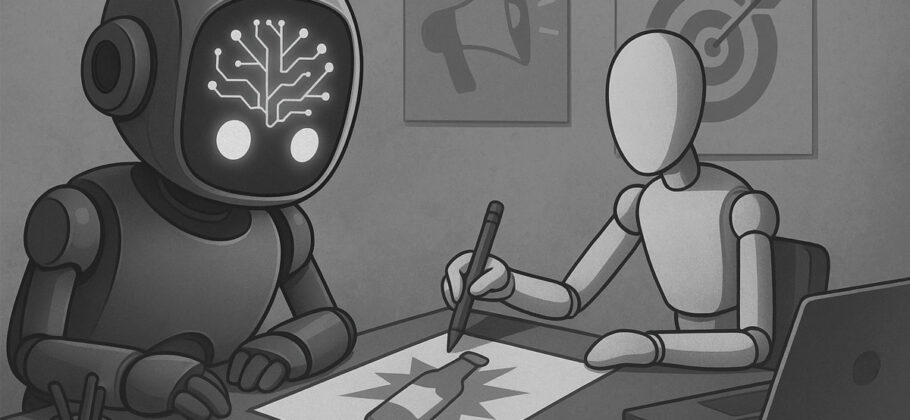The advertising industry is going through one of its most turbulent periods in recent history. Artificial intelligence has stopped being a futuristic idea and has become a powerful force reshaping how ads are created, pitched, and delivered to audiences. Some people see this as a renaissance full of opportunity, while others describe it as a slow-motion collapse of the business models that agencies have relied on for decades.
What Will Be Different
AI is transforming almost every step of the process that agencies have traditionally controlled. Creative directors are already relying on tools like Midjourney to produce realistic images and video storyboards in a matter of hours rather than weeks. Voice cloning allows agencies to create convincing samples of celebrity endorsements within minutes. Campaigns that would have required months of planning and production are now being delivered in as little as six weeks.
This level of efficiency is forcing agencies to reconsider how they charge for their services. The old system of billing clients by the hour is becoming harder to defend when technology can produce ideas and content so quickly. Martin Sorrell, the executive chairman of S4 Capital, said during an earnings call that some agencies are adapting their pricing models to focus on “assets or outputs delivered” instead of labor time. He explained that AI has simply reduced the hours needed to manage and create campaigns, pushing the industry to find new ways to prove value.
AI is also expanding the scope of what agencies can offer. Eric Wegerbauer, the chief creative officer at TBWA, said his team recently pitched a project that would deliver nearly one million personalized versions of a single ad to target individual customers. In his words, “You’d just never ever, ever do that without AI.”
What Will Be Better
Many creative leaders believe that AI is not destroying their craft but actually strengthening it. Elena Knox, an executive creative director at BBDO New York, said AI has helped her team secure multimillion-dollar projects by letting clients see and hear a concept in ways that used to be impossible. She described a recent pitch where her team used AI tools to create a GIF of an office transforming into a forest, something that convinced the client to invest in shooting the campaign across New Zealand and Bulgaria.
“Before you would have had to spend hours comping that, and the image wouldn’t have existed,” Knox explained. “In AI, we were able to make a quick GIF of it and show the clients: This is what we want to film.”
In another case, Knox used an AI-generated voiceover to let a client hear exactly how a particular celebrity would sound in their campaign. “There’s nothing like hearing the thing and being like, well, I can’t unhear that,” she said.
Agencies are also using AI to help clients with smaller budgets compete in ways they could not before. BETC, an agency in Paris, worked with the laundry detergent brand Woolite to launch a new campaign without the big celebrity shoots the company had used in the past. Instead, they created a digital mascot called the Fluffy GOAT, which appeared on yachts and private jets in a series of ads. Alasdhair Macgregor Hastie, BETC’s executive creative director, said the entire campaign was completed in six weeks instead of the usual three to six months.
“AI to me is something that can only enhance what we do,” Hastie said. “I’m old enough to remember when Photoshop came in and people were wailing and moaning it was the end of advertising. Photoshop became a tool, and if we don’t adapt to the new tool, then the new tool is going to take over.”
What Will Be Worse
Despite these breakthroughs, the AI transition is already creating serious challenges. Barclays analysts recently downgraded the stocks of major ad holding companies such as Interpublic, Omnicom, and WPP, pointing to persistent low growth as agencies try to reinvent themselves. In their note, the analysts wrote, “We have been longstanding agency bulls but we came away from all these meetings more bearish than before.” They predicted that the current slow growth of about 2 percent for the top agencies would likely continue because the industry needs time, money, and solid execution to adapt.
AI is also eroding the foundation of how agencies nurture new talent. Many of the simpler tasks that junior employees used to perform are now automated. Knox and others worry that if young professionals do not have hands-on experience with production basics, it will be much harder to grow into senior creative roles over time.
Another concern is that AI relies on data from the past, which can lead to content that feels repetitive and safe. As the Barclays analysts put it, technology could make the work “so accessible that marketers feel less need to hire agencies in the first place.”
Who Will Survive
These changes are already reshaping the competitive landscape. Large platforms such as Meta are building AI tools that can automate ad creation and placement for small businesses. Mark Zuckerberg said in an interview that soon “you don’t need any creative” to generate ads for small companies. However, Barclays believes Meta will not fully replace agencies because it mainly serves smaller advertisers, while the biggest brands still rely on agencies for strategy and scale.
For independent agencies, the disruption may be an opportunity. In London, Mother continues to thrive as an example of a creative shop that refuses to be absorbed by a holding group. A neon sign reading “Not for Sale” hangs in its Shoreditch office. Katie Mackay-Sinclair, a global partner at Mother, described the agency as a “safe haven in a zombie apocalypse.”
Miranda Hipwell, chief executive of Adam & Eve DDB, said that London agencies still have a distinctive spirit. “Creatives in London are still a bit scrappy and there is an energy and grittiness here,” she observed. Felix Richter, Mother’s chief creative officer, added, “America has the innovation but Europe has the craft: the attention to detail and nuance that makes something really original.”
What Commenters Are Saying
Industry opinions are split. Sam Altman, CEO of OpenAI, predicted that “95% of what marketers use agencies, strategists, and creative professionals for today will easily, nearly instantly, and at almost no cost be handled by AI.” Others are less certain that AI will fully replace human creativity.
BofA Global Research analysts pointed out that agencies have always been adaptable. They wrote, “Agency holdcos have a deeply engrained tradition of adaptability and partnerships.” They cited recent deals like WPP’s agreement to use TikTok’s AI tools and Omnicom’s new technology partnerships as examples of how the industry is evolving.
Goldman Sachs analysts said that AI could eventually expand the entire advertising market by making campaigns more effective. “AI automating many aspects of the advertising value chain and lowering barriers to entry into certain channels or ad formats for advertisers may expand the number of businesses globally that deploy ad spend,” they explained.
Whether AI becomes the downfall of agencies or the engine that drives their growth will depend on how well they embrace change and prove that creativity still has value no matter how advanced the tools become.





